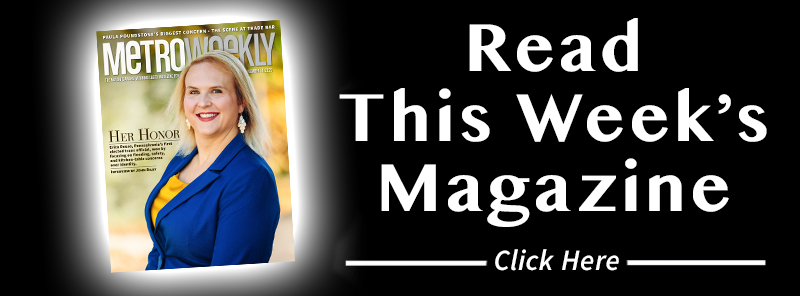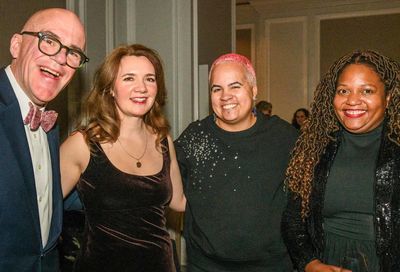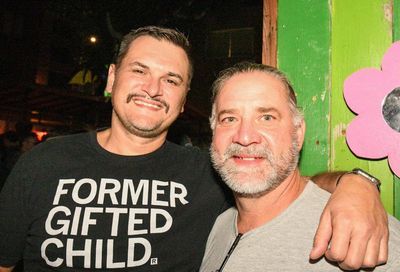Julie Scofield
National Alliance of State and Territorial AIDS Directors
Among the quotes one could only hear in Washington, add the following: ”I have a great passion for the role of state government.” It’s a wonky-sounding statement in a city brimming with wonks.
But for Julie Scofield, that passion isn’t just about the policy — it’s about what can be done. She worked for the state of New York at the beginning of the AIDS epidemic, where she learned how states can make a difference in a burgeoning crisis.
In 1993, Scofield helped launch the National Alliance of State and Territorial AIDS Directors (NASTAD), which represents the public health employees from every state and U.S. territory who are directly responsible for the care, treatment and prevention of HIV/AIDS in their locales. During the first six months, she was the executive director and sole employee. Today, she’s heading an organization with 25 employees and scope that encompasses both national and international efforts.
 Scofield |
”When I opened the doors of NASTAD my children were 4 and 8 years old — now they’re 21 and 17,” she laughs, putting her time into perspective.
While the GLBT community may be familiar with such long-time national advocacy groups such as AIDS Action, the National Association of People with AIDS, and the National Minority AIDS Council, few outside of advocacy circles have heard of NASTAD. But they are heavily involved in advocating for effective national policy and funding strategies, working in particular with the Centers for Disease Control and Prevention (CDC) and other government agencies, as well as conducting lobbying and education efforts on Capitol Hill.
Scofield says that HIV/AIDS remains a unique challenge for advocacy, but one that draws a uniquely committed group of advocates.
”We contend with all of the issues that confront our society around racism, classism, homophobia — things that our country doesn’t like to talk about, such as sexual behavior and drug use,” she says. ”I think people come to this work because they are passionate about it.
[Editor’s note: This writer worked for NASTAD from 1995 to 2000, providing HIV prevention program training to state health departments and community organizations.]
METRO WEEKLY: How do you describe NASTAD and what it does?
JULIE SCOFIELD: We really work at the intersection of the advocacy community and government, because we’re in this unique situation. We work closely with other national AIDS organizations, but our members are state government, so we also work with governmental entities. We’re a policy-focused organization — we tap into the expertise of our members to make recommendations on sound national policy and HIV and AIDS. We’re active on Capitol Hill — we do lobbying and advocacy, but I think that a lot of what we do is education. And then we’re a technical assistance organization. We take great pride in the fact that we work with our members to help them do a better job out in the states. We focus a lot of our time and energy on our peer technical assistance model and addressing the needs of the states.
The impetus for the organization’s [formation in 1993] was clearly to have a voice on the Hill and with the administration and in the coalitions of national AIDS organizations who were more directly involved with where we were headed as a nation. We’re still very much concerned about the voice of the states in all of these conversations. What’s changed is that we’ve continued to grow and some of the other organizations have really been struggling to find their way and keep their doors open.
MW: Why do you think some organizations have struggled?
SCOFIELD: One of the big issues is the success that we’ve seen in treatment in this country. It’s been difficult to keep the grassroots engaged in national AIDS policy and in advocacy work because people are living so well with HIV/AIDS now. That is the success of all the work that we’ve done, but the flip side of it is that there’s not the urgency that there was.
It’s also a tough fiscal environment that we’re working in. There are lots of competing interests for lots of donors and HIV/AIDS has sort of fallen off the top tier. So I think that’s part of it as well. And I think the current context in which we’re doing our work politically has made it a bit of a struggle to keep finding ways to support our work.
One of the things I’m proudest of is our AIDS Drug Assistance Program Crisis Task Force. Given the current fiscal climate and how difficult it’s been to get sufficient funding for state ADAPs, it’s the work of our Task Force that’s keeping the doors open for programs across the country right now. It’s a story that we don’t talk about an awful lot because we don’t want to take the pressure off the administration and Congress to step up to the plate and adequately fund treatment in this country. But the work that we’ve done with industry to keep a lid on costs and to negotiate rebates has been enormously successful.
MW: Is treatment still an easier sell than prevention when it comes to federal funding and policy?
SCOFIELD: Absolutely. We are still struggling with how to get messages across that convince policy makers that prevention is a worthwhile investment. And we’re stuck in this national dialogue that makes no sense to me, about how the fact that we have 40,000 new infections every year means that prevention has failed. I think the absolute opposite is true. That we only have 40,000 new infections every year means that prevention has been an incredible success, because we have so many more people living with HIV in this country. For HIV prevalence, the curve is straight up, yet we’re keeping new infections down. But again, having that kind of conversation with folks in a compelling way has been excruciatingly difficult.
Opponents of prevention have used the 40,000 number as part of the foundation of their claim that prevention doesn’t work. It’s been difficult to make the case about how well prevention is working because it’s a complex issue. Treatment is a simple thing to explain to people: If you get on treatment and you get the right therapy, the viral load goes down and people are very healthy. But with prevention, it’s not like a single intervention or one particular program is yielding success. You have to have a comprehensive approach to prevention that includes different kinds of interventions to really have an impact and it’s really hard to measure how well they’re working. But my feeling is that it takes all of them, in some dose that’s not perfectly prescribed, to have an impact. It means having interventions that are focused on individuals, on groups, on communities. And it means having behavioral interventions. It means having accessible counseling and testing and good referral into care and treatment.
But let me say this, because I couldn’t have this interview without talking about this data: [data from a five-city study] found that 46 percent of black gay men are HIV infected and 60 percent of those men weren’t aware of their infection. That’s a crisis. From my perspective, it’s a national crisis. I don’t want to see a generation of young, black gay men get infected and die.
MW: Why are we not having that level of prevention success with black gay men?
SCOFIELD: There are societal and cultural barriers that are still really prominent, particularly pertaining to being black in the United States of America, being gay in the United States of America, being gay and black in the United States of America. We’re talking about a stigmatized population. And the research on the population is shaky, in terms of us having done the behavioral research in this population to really know what’s going on there. There are lots of needs that aren’t being addressed.
MW: I’ve heard criticism of NASTAD about what state health departments actually do, or do not do, for certain populations, such as black gay men. How do you address those concerns that some health departments are doing a better job than others in outreach to stigmatized communities?
SCOFIELD: NASTAD has convened an African American Advisory Committee since the late ’90s and the membership of that Advisory Committee are African-American AIDS directors and senior program staff working in state health departments. The first thing they did was contribute to the development of a monograph that focused on developing a conversation with health departments about looking at how they can do a better job of reaching African-American communities. It really started with a sort of self-evaluation of the impact of institutionalized racism, the legacy of slavery in this country, the legacy of [the] Tuskegee syphilis experiments, and how public health has historically been bad in terms of working with African-American communities. That can still have an impact on why health departments succeed or don’t succeed in building relationships with African-American communities that are going to result in sound HIV prevention and care programs.
So we really tried to get health departments to take a look at themselves internally to see what they could be doing better. And it has also meant getting health departments to look at how to build African-American leadership within health departments and to have a more diverse program staff, which we think is incredibly important.
We issued a call to action in November on HIV/AIDS and African Americans, to say that collectively health departments need to do more, need to take a look at what they’re doing, need to refocus their energy given what’s happening in African-American communities. We’re hoping that by having our leadership talking about this as a priority it has an impact on our membership in terms of taking a look at what’s going on in their communities and in their health departments.
MW: Another issue is the lack of gay African Americans leading HIV/AIDS organizations. You’ve been here for 13 years, a straight white woman running this national AIDS group. Is it difficult, when you look around at your own contemporaries, to see the levels of representation, particularly with the current state of the epidemic?
SCOFIELD: We all really struggle with that issue. I don’t think NASTAD is unique in that. We have that extra challenge of finding people of color who want to work for an agency whose members are state bureaucrats. We’re not an advocacy organization like NAPWA (National Association of People with AIDS) or AIDS Action, so I think we have some special challenges, but I think we’ve done a reasonably good job trying to recruit a very diverse staff. I’m proud of the work we’ve done. It’s an ongoing challenge. If I were to leave this position tomorrow, I would not recommend to the board to hire somebody like me to replace me. But I’m not ready to step aside yet because I still have too much work to do.
MW: I know many people got involved working with HIV/AIDS organizations for personal reasons: friends or loved ones who were infected with or died from the virus. Do you have a personal stake involved in this?
SCOFIELD: It has always been frustrating to me that in the history of the AIDS epidemic we were light on people not directly affected by the epidemic to lead the charge. When I read about the first cases of this disease that you could get from having sex and that could kill you, I was appalled. I was raised in the generation where all you had to do was get a shot of penicillin and it would cure anything and everything. Cancer was the thing that you had to be afraid of, or, if you were sexually active, herpes, which didn’t kill you. And so when I first read about AIDS, I thought, ”Oh my God, I can’t believe there’s something out there that can kill you that quickly and that you can get from sex. I know that we’re going to rally the forces of this wealthy nation and cure it immediately.” And I was appalled that our government was so slow to respond. I was appalled that we had to wait for populations who were being directly affected to make systems move. There have to be allies who aren’t directly affected to rally to the cause. That’s been enough [of a stake] for me.
MW: What about the political climate, particularly on the Hill with Republicans in charge of both Congress and the White House?
SCOFIELD: We have a lot of folks who are friends — the struggle, as it has always been, is finding members of the House or Senate who are willing to champion the cause. By and large, we find that lots of offices are receptive to our messages and it’s not that difficult to get meetings with them. What’s difficult is to get members to go from being generally supportive to carrying the issue into a committee — to trade something to get something for the HIV/AIDS community. That’s always been the challenge. 2005 was the beginning of Ryan White CARE Act reauthorization, so we are in that part of the legislative cycle where there are more meetings going on and I think we’ve saturated the place with discussion on our issues.
MW: Abstinence-only HIV prevention efforts have continued to be a priority for this administration. What’s NASTAD’s position on that abstinence-only?
SCOFIELD: We feel that the funding ought to follow the science base and there is no science base for the abstinence-only approach. It just isn’t proven to work, and we should be investing money in programs for which there is some science base. It is very frustrating that [the government] found new money for [abstinence programs] every year at a time when the rest of the prevention programs are being cut. Those cuts are really starting to diminish the capacity of health departments to do the kind of prevention work that we need to do. We need to increase funds for prevention, not cut them. So that’s very frustrating, that when there’s a new dollar to be found it’s been going to unproven abstinence-only programs as opposed to sound programs in the rest of the prevention portfolio.
MW: How do policy makers or politicians who advocate abstinence-only programs respond to the argument that if abstinence is postponing sexual activity until marriage then, by definition, gay communities are effectively left out under an abstinence-only prevention approach?
SCOFIELD: I don’t even think the conversation gets to that level. I think on the surface of things, the way things have worked recently [in Congress], if the funding request gets into the president’s budget, by and large he’s going to get it. I don’t think we’ve had that many forums where the conversation has gotten to that level of sophistication.
MW: On World AIDS Day this year, what do you believe is important for people to be thinking of in terms of the HIV epidemic, in particular for the gay community in the U.S.?
SCOFIELD: Gay men’s health and wellness is an incredible concern to me. That includes HIV, it includes sexually transmitted disease, it includes substance use, it includes mental health issues. It’s incredibly important for the gay community to mobilize around health and wellness for gay men in this country. It’s still incredibly important for white gay men, where we are still seeing increases in HIV infections, where we’re seeing syphilis outbreaks, where there is an incredible problem with crystal meth use. And all those things have also exacerbated the problems with HIV among African-American gay men and other gay men of color who also face stigma and potential discrimination. That’s where I would focus the message for World AIDS Day.
For more information on NASTAD’s programs, visit www.nastad.org.
Support Metro Weekly’s Journalism
These are challenging times for news organizations. And yet it’s crucial we stay active and provide vital resources and information to both our local readers and the world. So won’t you please take a moment and consider supporting Metro Weekly with a membership? For as little as $5 a month, you can help ensure Metro Weekly magazine and MetroWeekly.com remain free, viable resources as we provide the best, most diverse, culturally-resonant LGBTQ coverage in both the D.C. region and around the world. Memberships come with exclusive perks and discounts, your own personal digital delivery of each week’s magazine (and an archive), access to our Member's Lounge when it launches this fall, and exclusive members-only items like Metro Weekly Membership Mugs and Tote Bags! Check out all our membership levels here and please join us today!


























